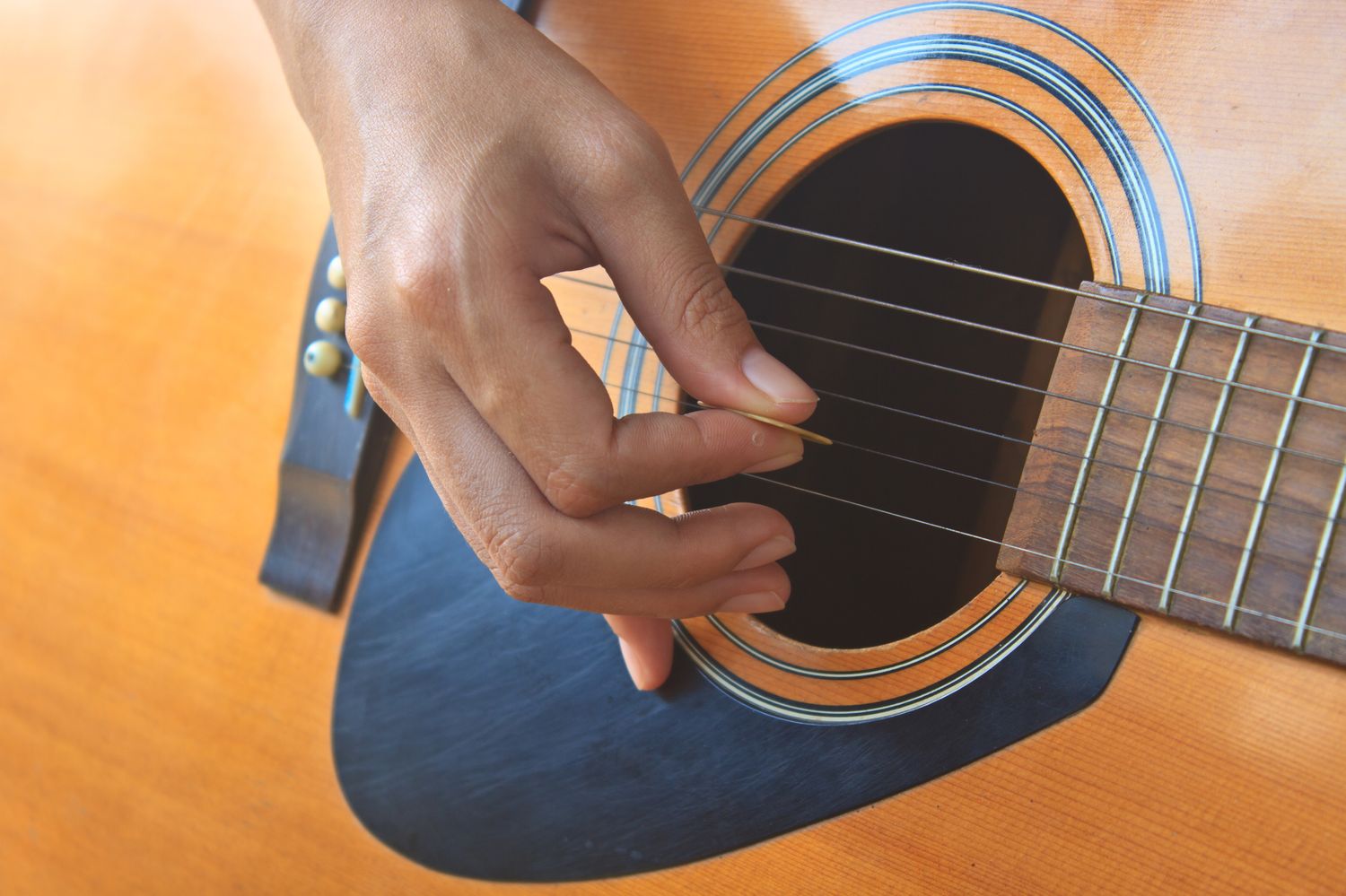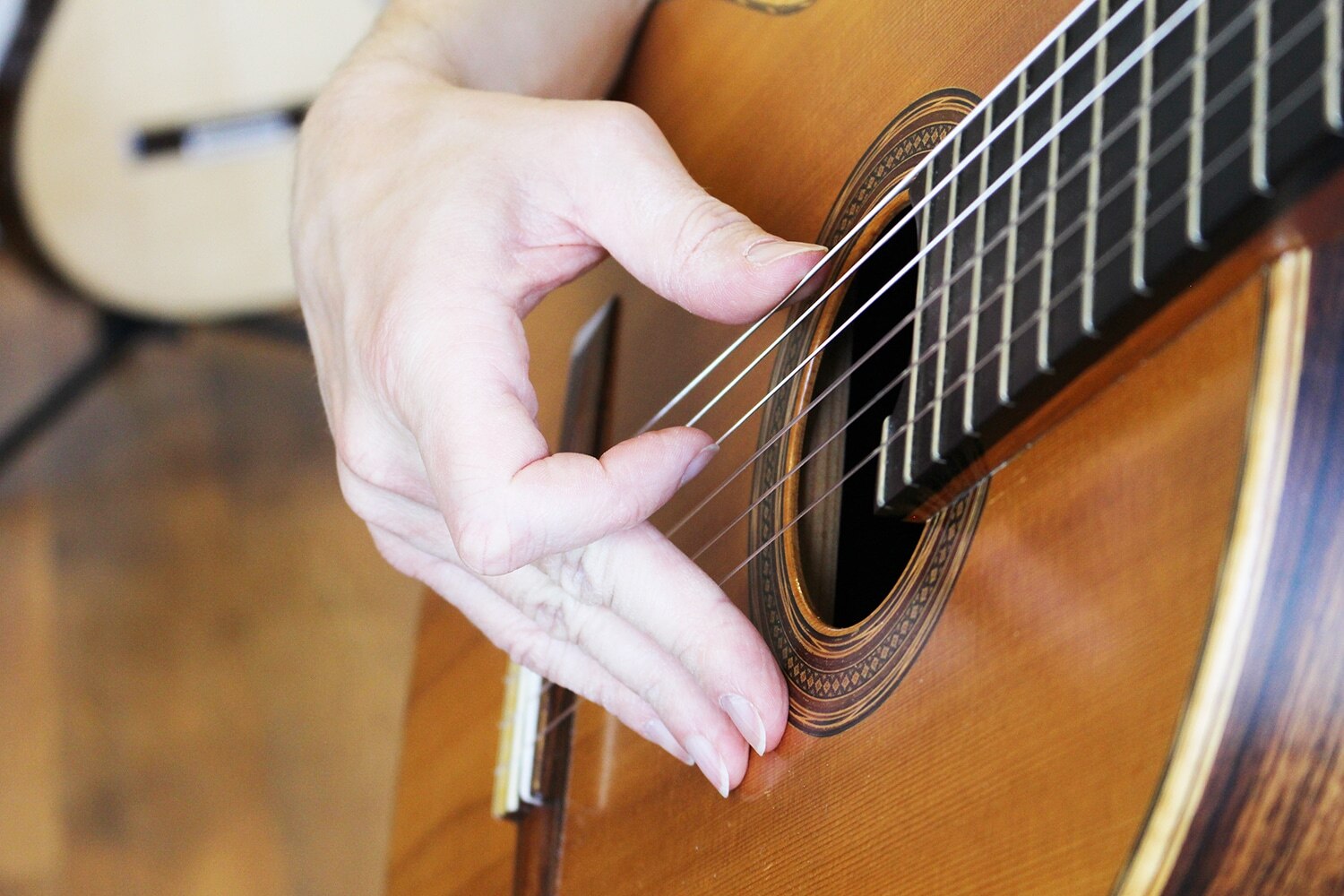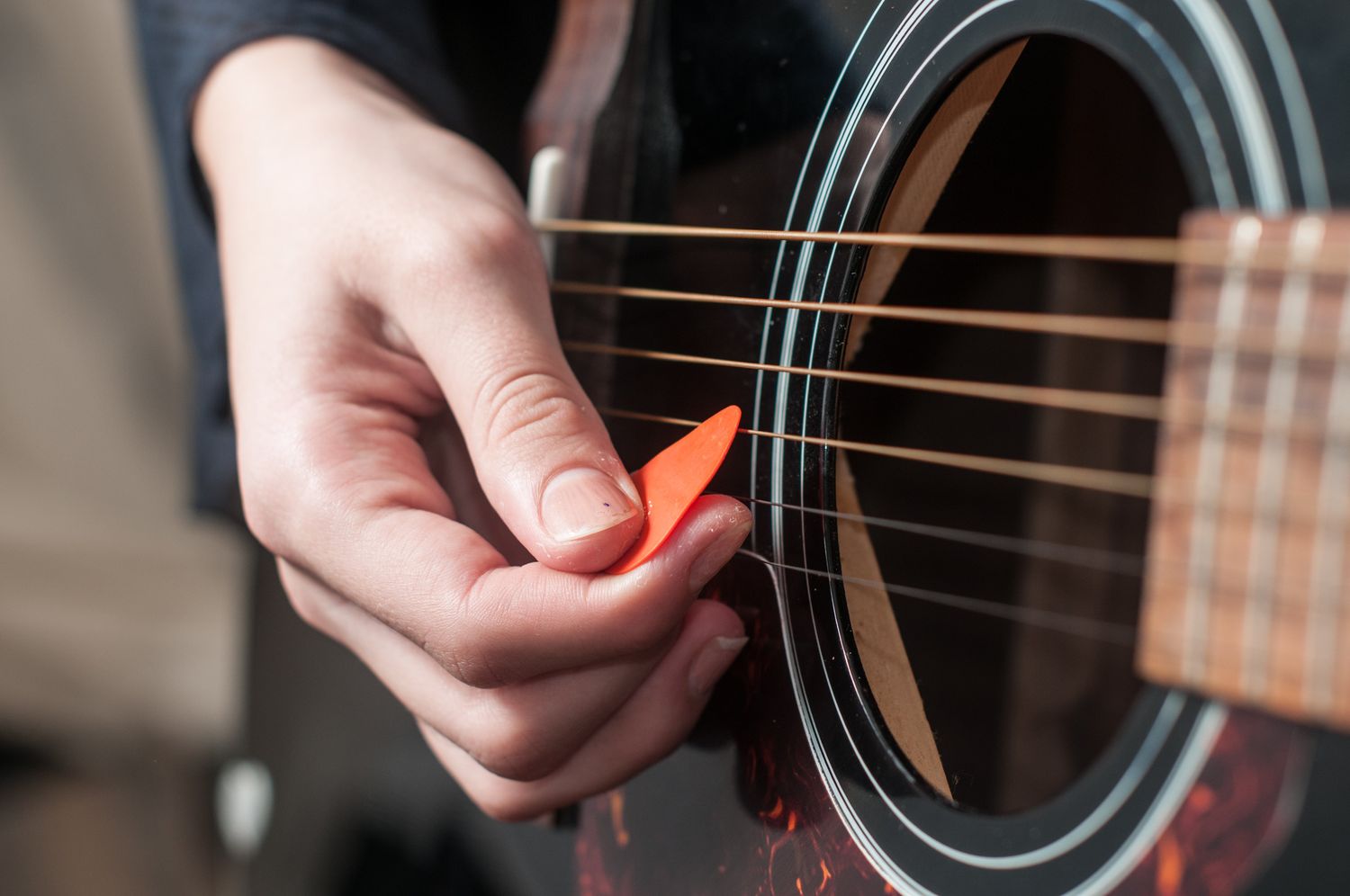Home>Instruments>Guitar>How To Hold A Pick Guitar


Guitar
How To Hold A Pick Guitar
Published: February 13, 2024
Learn how to properly hold a guitar pick and improve your guitar playing technique with our step-by-step guide. Master the art of holding a pick for better guitar performance.
(Many of the links in this article redirect to a specific reviewed product. Your purchase of these products through affiliate links helps to generate commission for AudioLover.com, at no extra cost. Learn more)
Table of Contents
Introduction
Playing the guitar is a fulfilling and enjoyable endeavor that offers a creative outlet and a means of self-expression. Whether you're a beginner or a seasoned guitarist, understanding the fundamentals of holding a pick is crucial for producing clear and resonant tones. The pick, also known as a plectrum, is a small, flat tool used to pluck or strum the strings of a guitar. While it may seem straightforward, the technique of holding a pick significantly impacts the sound and overall performance. In this guide, we'll delve into the art of holding a guitar pick, exploring the nuances of choosing the right pick, achieving a proper grip, and mastering essential strumming and picking techniques.
Mastering the art of holding a guitar pick is fundamental to developing a strong foundation in guitar playing. The pick serves as an extension of the guitarist's fingers, allowing for precise and controlled movements across the strings. By understanding the intricacies of pick selection and grip, aspiring guitarists can unlock their full potential and elevate their musical capabilities. Whether you aspire to strum along to your favorite songs, dazzle audiences with intricate melodies, or simply enjoy the therapeutic benefits of playing the guitar, honing your pick-holding skills is an essential step on your musical journey.
In the subsequent sections, we will explore the nuances of selecting the right pick for your playing style, mastering the proper grip to optimize control and dexterity, and implementing effective strumming and picking techniques to enhance your musical prowess. With dedication, practice, and the insights shared in this guide, you'll be well-equipped to navigate the world of guitar playing with confidence and proficiency. Let's embark on this enlightening journey to unravel the secrets of holding a guitar pick and harnessing its transformative power in your musical endeavors.
Choosing the Right Pick
When it comes to selecting a guitar pick, the options can seem overwhelming, with a myriad of shapes, sizes, and materials available. Each pick attributes distinct tonal qualities and influences the overall playing experience. As a guitarist, it’s essential to consider various factors to determine the most suitable pick for your playing style and musical preferences.
One of the primary considerations when choosing a pick is the material. Picks are commonly crafted from materials such as plastic, nylon, celluloid, and even metal. Each material offers unique characteristics, affecting factors such as flexibility, durability, and tone production. For instance, plastic picks provide a balanced blend of flexibility and sturdiness, making them versatile for different playing techniques. On the other hand, nylon picks offer a smoother surface and a distinct feel, ideal for producing a warm and rounded tone.
Furthermore, the thickness of the pick significantly influences the playability and tonal output. Thinner picks, typically ranging from 0.38mm to 0.60mm, offer increased flexibility and are well-suited for strumming and rhythm playing. Conversely, thicker picks, ranging from 0.80mm to 1.50mm or more, provide enhanced control and precision, making them ideal for intricate lead lines and soloing.
Additionally, the shape of the pick contributes to its functionality and playability. Standard picks feature a teardrop shape, allowing for a versatile performance across different musical genres. Alternatively, picks with a jazz or pointy tip offer a sharper attack and increased articulation, making them well-suited for intricate picking patterns and soloing.
Ultimately, the ideal pick is a matter of personal preference, influenced by factors such as playing style, musical genre, and individual comfort. Experimenting with various picks and considering their impact on tone, playability, and comfort is essential for finding the perfect match for your musical journey. By understanding the nuances of pick selection, you can tailor your playing experience to align with your artistic vision and unlock the full potential of your musical expression.
Proper Grip
Mastering the art of holding a guitar pick with the proper grip is essential for achieving precision, control, and fluidity in your playing. The pick should be held between the thumb and index finger, allowing for seamless movement across the strings while maintaining stability and dexterity. While the technique may vary slightly among guitarists, there are fundamental principles to consider when refining your pick-holding grip.
Begin by positioning the pick between the pad of your thumb and the side of your index finger. The pick should align parallel to the index finger, with a small protrusion extending beyond the fingertip. This protrusion enables the pick to make contact with the strings, producing clear and defined notes. Additionally, maintaining a relaxed grip is crucial for facilitating fluid movement and preventing muscle tension, which can impede playing dynamics.
Experiment with the placement of the pick to find a comfortable and natural position that allows for effortless strumming and picking. Some guitarists prefer to angle the pick slightly towards the guitar’s body, while others may opt for a perpendicular alignment. The angle at which the pick meets the strings can influence the attack, tone, and overall feel of the playing experience, so it’s beneficial to explore various angles to discover what best suits your playing style.
Furthermore, consider the amount of the pick that extends beyond your fingers. A protrusion of approximately 1/4 to 1/2 inch is a common starting point, but this can be adjusted based on individual comfort and playing preferences. Finding the optimal amount of pick protrusion facilitates smooth string contact and allows for nuanced control over dynamics and articulation.
It’s important to note that the grip should feel natural and relaxed, promoting fluidity and ease of movement across the strings. Avoid gripping the pick too tightly, as this can hinder agility and lead to muscle fatigue. Striking a balance between stability and flexibility is key to refining your pick-holding technique and enhancing your overall playing experience.
By honing the art of the proper pick grip, you’ll lay the groundwork for executing a wide range of playing techniques with finesse and confidence. Whether you’re strumming chords, unleashing expressive solos, or exploring intricate fingerstyle patterns, a well-refined pick grip is the gateway to unlocking your full creative potential as a guitarist.
Strumming Techniques
Strumming is a foundational skill that forms the rhythmic backbone of countless songs across various musical genres. Mastering strumming techniques not only enhances your ability to accompany melodies but also allows for dynamic expression and rhythmic flair. Whether you’re strumming gentle acoustic ballads or driving power chords in a rock anthem, refining your strumming technique is essential for delivering compelling and engaging performances.
One of the fundamental aspects of strumming is achieving a consistent and fluid motion across the strings. Begin by positioning your picking hand comfortably above the soundhole or bridge of the guitar, allowing for ample room to execute strumming patterns. The motion should originate from the wrist, with a relaxed and fluid movement that flows naturally across the strings. Maintaining a steady rhythm and even pressure during strumming ensures a balanced and resonant sound.
Experiment with varying degrees of force and velocity to produce diverse tonal textures. Light, delicate strumming creates a subdued and airy ambiance, ideal for introspective passages and softer compositions. Conversely, employing a more vigorous and assertive strumming approach yields a robust and commanding sound, perfect for driving rhythms and energetic performances.
Furthermore, incorporating rhythmic accents and syncopated patterns adds depth and character to your strumming. Emphasizing certain beats within a measure or introducing offbeat strums injects rhythmic dynamism into your playing, elevating the overall musical impact. By mastering the art of rhythmic nuance, you can infuse your strumming with personality and groove, captivating listeners and enhancing the musical narrative.
It’s essential to explore a diverse repertoire of strumming patterns, ranging from standard downstrokes and upstrokes to intricate arpeggiated sequences. Varying your strumming patterns enriches your musical palette, allowing for versatility and adaptability across different musical styles and compositions. Additionally, integrating percussive elements, such as muted strums and rhythmic accents, adds a percussive dimension to your strumming, creating a compelling rhythmic foundation for your music.
Ultimately, mastering strumming techniques empowers you to convey emotion, drive, and rhythmic vitality through your guitar playing. Whether you’re leading a sing-along around a campfire or performing on stage in front of a captivated audience, honing your strumming skills amplifies your ability to connect with listeners and breathe life into your musical expressions.
Picking Techniques
Refining your picking techniques is pivotal for unlocking a diverse range of expressive possibilities on the guitar. Whether you aspire to deliver intricate melodies, blazing solos, or intricate fingerstyle arrangements, mastering the art of picking techniques is essential for achieving clarity, precision, and dynamic control.
One of the fundamental picking techniques to explore is alternate picking, which involves seamlessly alternating between downstrokes and upstrokes. This technique fosters fluidity and evenness in your playing, enabling you to navigate scales, arpeggios, and melodic passages with efficiency and finesse. By incorporating alternate picking into your practice regimen, you’ll cultivate a strong foundation for executing intricate and rapid passages with accuracy and fluency.
Furthermore, economy picking, also known as sweep picking, is a technique that optimizes the efficiency of motion by minimizing unnecessary movements. This approach involves using a continuous picking motion in the direction of the strings’ travel, particularly beneficial for arpeggiated patterns and rapid scalar runs. By integrating economy picking into your repertoire, you can streamline your playing technique and execute complex passages with heightened agility and precision.
Exploring hybrid picking introduces a versatile and dynamic dimension to your playing, combining the use of a pick and fingers to pluck the strings. This technique enables you to seamlessly blend pick-driven passages with intricate fingerstyle embellishments, expanding your sonic palette and expressive capabilities. Whether you’re crafting melodic textures or embellishing chord progressions, hybrid picking offers a nuanced and multifaceted approach to guitar playing.
Additionally, incorporating string skipping techniques into your practice routine broadens your melodic and harmonic scope, allowing for the creation of expansive intervals and captivating melodic leaps. String skipping entails navigating non-adjacent strings, fostering a sense of spaciousness and intervallic exploration in your playing. By mastering this technique, you can infuse your compositions with captivating leaps and unconventional melodic contours, adding depth and intrigue to your musical expressions.
Ultimately, honing your picking techniques equips you with the technical prowess and creative versatility to articulate your musical ideas with clarity, expressiveness, and virtuosity. Whether you’re embarking on a soul-stirring solo or weaving intricate tapestries of melody and harmony, the art of picking techniques amplifies your capacity to convey emotion, narrative, and musical depth through the evocative language of the guitar.
Conclusion
As we conclude our exploration of holding a guitar pick, it’s evident that this seemingly simple tool holds profound significance in the realm of guitar playing. From selecting the right pick to mastering essential grip and techniques, the art of holding a guitar pick is a gateway to unlocking a world of musical expression and creativity. By understanding the nuances of pick selection, achieving a proper grip, and honing strumming and picking techniques, guitarists can elevate their playing to new heights and embark on a journey of sonic exploration and artistic fulfillment.
Choosing the right pick is a deeply personal endeavor, influenced by factors such as material, thickness, and shape. Each pick attributes distinct tonal qualities and playability, shaping the sonic landscape and tactile experience for the guitarist. Through experimentation and thoughtful consideration, guitarists can discover the perfect pick that resonates with their playing style and artistic vision, enriching their musical expressions with depth and character.
Mastering the art of the proper pick grip lays the foundation for executing a diverse array of playing techniques with finesse and confidence. By striking a balance between stability and flexibility, guitarists can navigate the fretboard with precision and fluidity, unleashing a spectrum of rhythmic and melodic possibilities with ease and dexterity.
Furthermore, delving into the realms of strumming and picking techniques empowers guitarists to convey emotion, drive, and rhythmic vitality through their playing. Whether strumming captivating chord progressions or delivering blistering solos, the mastery of picking techniques amplifies the guitarist’s capacity to connect with listeners and breathe life into their musical expressions.
As aspiring and seasoned guitarists alike embark on their musical odyssey, the art of holding a guitar pick stands as a testament to the profound impact of seemingly small details in shaping the grand tapestry of musical artistry. With dedication, practice, and a deep understanding of pick selection, grip, and techniques, guitarists can harness the transformative power of the pick and embark on a journey of sonic exploration, creative innovation, and boundless musical expression.











